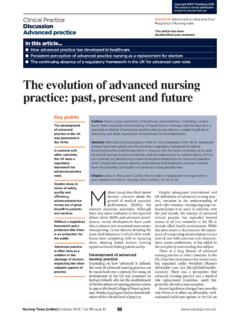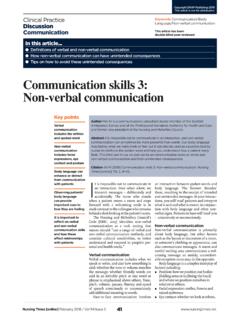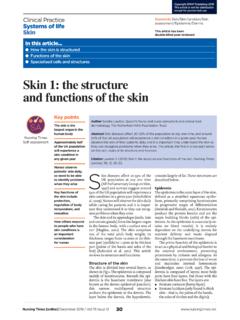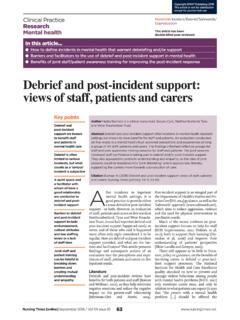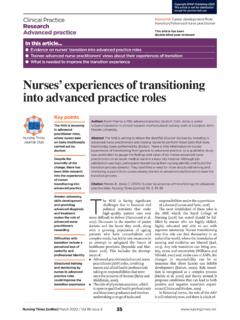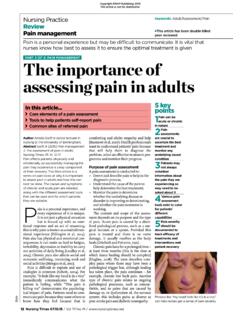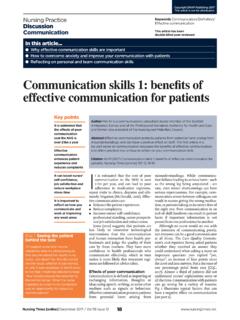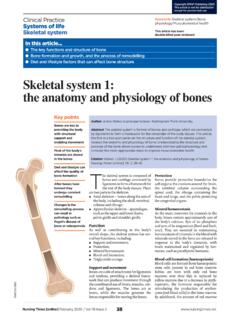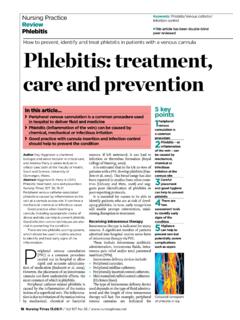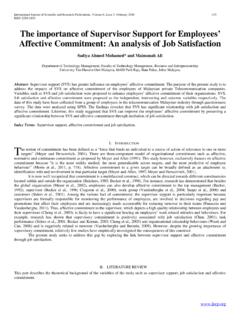Transcription of Workplace conflict: why it happens and how to manage it
1 Copyright EMAP Publishing 2019 This article is not for distributionexcept for journal club use26 Nursing Times [online] March 2019 / Vol 115 Issue 3 comprise the largest pro-fessional group in healthcare and may find they are caught in the middle of Workplace con-flicts they are ill-prepared to deal with. Much of their training revolves around demonstrating caring and compassionate behaviour (Northam, 2009; Askew et al, 2008; Johnson et al, 2007), with little prep-aration for conflict management. This article looks at Workplace conflict in the NHS, why it happens , how to decipher it and what to do about it. The NHS is the largest employer in Europe and the fifth largest in the world, with over million staff (Nuffield Trust, 2018).
2 It is considered inevitable that, in such a complex and multiprofessional system, conflicts will occur (Kaitelidou et al, 2012; Hendel et al, 2007). Working in healthcare is emotionally and physically demanding, and can be exacerbated by long hours and teams competing for resources (De Dreu and Gelfand, 2013). Sta-tistics on Workplace conflict are difficult to obtain, as they are often hidden in data on staff turnover, sickness rates and number of grievance cases. Conflict can arise from many factors, such as internal power structures, incom-patible personalities and differing beliefs and opinions.
3 It may well be part of the nat-ural emotional landscape at work and it is likely that a totally harmonious Workplace is impossible to achieve. If episodes of dis-cord between staff are inevitable, current management strategies which focus on reducing or eliminating conflict need to be replaced. To develop new, effective strat-egies, the nature of Workplace conflict and why it occurs must be understood. Compounding factorsBowie (2011) notes that bullying or mob-bing behaviours are increasing in the work-place, largely due to the economic climate: decreasing job security is pitting staff against their colleagues.
4 Since care failings were highlighted in the Francis (2013) report, healthcare organisations have the added pressure of closer scrutiny, at a time when financial restrictions are forcing Keywords Workplace /Staff/Behaviour/Psychology/Bul lying This article has been double-blind peer reviewedKey points Nurses are often caught in Workplace conflicts but are ill-prepared to deal with them Conflict is inherent to complex, large and multiprofessional organisations such as the NHSW orkplace conflict can arise from communication, structural or personal issues Understanding how you react to conflict can help you find more-efficient ways to deal with itWorkplace conflict.
5 Why it happens and how to manage itAuthors Lesley Jones is head of clinical education at Cwm Taf University Health Board; Jane Harden is senior lecturer in adult nursing at Cardiff University; Mark Radford is director of nursing improvement; Jacqueline McKenna is director of nursing professional leadership, both at NHS Improvement. Abstract In a large and complex organisation such as the NHS, Workplace conflict is inevitable. It may arise from structural issues, incompatible personalities or differing opinions, and is exacerbated by demanding jobs, long hours, pressure on resources, organisational change and societal factors. A common strategy is to try to reduce or eliminate conflict but, if it is inherent to the Workplace , surely it is better to learn to manage it?
6 This article explores what causes conflict, the stages it follows and on what people need to reflect to be better able to deal with Jones L et al (2019) Workplace conflict: why it happens and how to manage it. Nursing Times [online]; 115: 3, this Causes of, and contributing factors to, Workplace conflict in healthcare A five-stage description of organisational conflict Questions to ask oneself when faced with Workplace conflictClinical PracticeDiscussionWorkplace conflictCopyright EMAP Publishing 2019 This article is not for distributionexcept for journal club use27 Nursing Times [online] March 2019 / Vol 115 Issue 3 conflictIf we accept that conflict is inevitable, we need to learn how to deal with it.
7 If we disa-gree with others about how to go about something, we need to: Marshal an argument that is objective; Deliver it in a way that others will not take personally. Failure to do this can lead to relation-ship conflict, which is far more problem-atic and often difficult to resolve. Robbins (1998) outlined organisational conflict in five stages (Fig 1). At stage 1, structure can cause conflict: the larger the group, the more specialised its activities and the greater the likelihood of conflict. Stage 4, when conflict becomes visible, is often when managers and/or HR depart-ments intervene. At stage 5, the interplay between parties results in consequences: conflict may be constructive and lead to improved outcomes, or be dysfunctional as unresolved issues breed discontent.
8 An awareness of these five stages (or of any of the models posited by organisational psy-chologists, given that they all follow sim-ilar patterns) will help identify conflict and manage it before it escalates. In a mixed-method doctoral study Jones (2016) interviewed four ward managers, two senior nurses and two executives (Box 1 features some of their comments) and surveyed 36 nurses before and after a con-flict management training. The study found that conflict was the new normal but was perceived differently depending on role and grade; it was experienced crosses over to become an interplay of dif-ferences in the interpretation of facts, expectations of other people s behaviours and incompatibility of goals.
9 There are multiple views of conflict. Most of us will have been brought up with the traditional view that it is harmful and must be avoided. Poor communication, lack of transparency and failure to respond to the workforce s needs are traditionally seen as causes of conflict but, from a human relations perspective, it can be argued that conflict is natural and inevi-table in any group. An interactionist per-spective would go further and argue that conflict is a positive force, or even a neces-sity for a group to perform effectively. However, it is difficult to view conflict as positive when you are in the middle of it.
10 There is little doubt in the literature that Workplace conflict has many negative effects on staff and organisations, and in healthcare any negative effect on staff might affect patient safety. Taylor and Rew (2010) considered the extreme end of work-place conflict Workplace violence as being more dangerous than exposure to blood-borne pathogens, falls or chemicals. Jones et al (2011) and Zampieron et al (2010), who concurred with these findings, also found conflict to be increasing. Vio-lence between patients and staff has been increasing, with hospitals looking at zero-tolerance policies to protect staff (Gault, 2018).
